During September we traditionally reflect on Mary, especially in her role as Sorrowful Mother.
As Fr. Frederick Faber wrote in At The Foot of the Cross
“Mary’s sorrows were not necessary for the redemption of the world, but in the counsels of God they were inseparable from it. They belong to the integrity of the divine plan. Are not Mary’s mysteries Jesus’ mysteries, and His mysteries hers? The truth appears to be that all the mysteries of Jesus and Mary were in God’s design as one mystery. Jesus Himself was Mary’s sorrow, seven times repeated, aggravated sevenfold.”
So, reflecting on the Seven Sorrows of Mary can be of great benefit. I wrote a series about the Seven Sorrows.
I also like to reflect on Mary in her “warrior mother” guise, as when she is using a weapon to protect her children. In general, human mothers, even of the critter sort, get pretty worked up if some threat goes after their offspring. Would Mary be any less concerned about us, in this vale of tears?
I’ve used this image of Mary on the sidebar of the blog quite often. Let’s beat the devil… with a club!
The title of this image is “Madonna del Soccorso… Our Lady of Succor, or Help”, painted in 1494 and it is found in the cloister of the Abbey of San Felice in Giano del Umbria, the Foundation house of the Missionaries of the Precious Blood.
Mary putting the smack down on the Devil with a club is a common theme. There are numerous depictions of the Devil trying to get at a soul, in the guise of a child running to mom for help.
We use our spiritual weapon when we pray the Rosary.
Mary uses her spiritual weapon when she beats the Devil.
I’ve written more about here HERE.
A few more versions just for nice.
It’s a whip this time. Gotta sting.
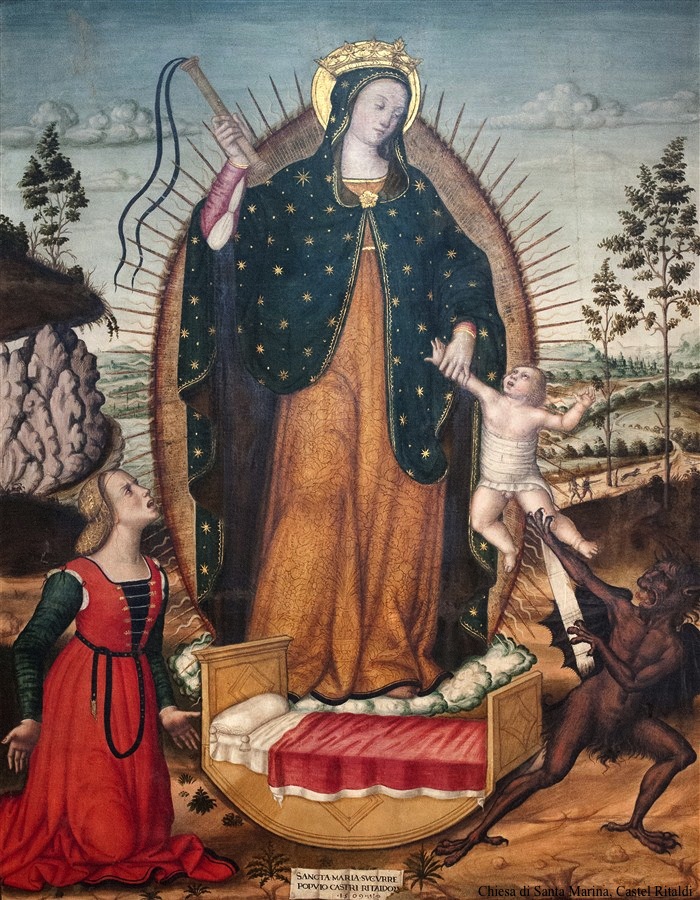
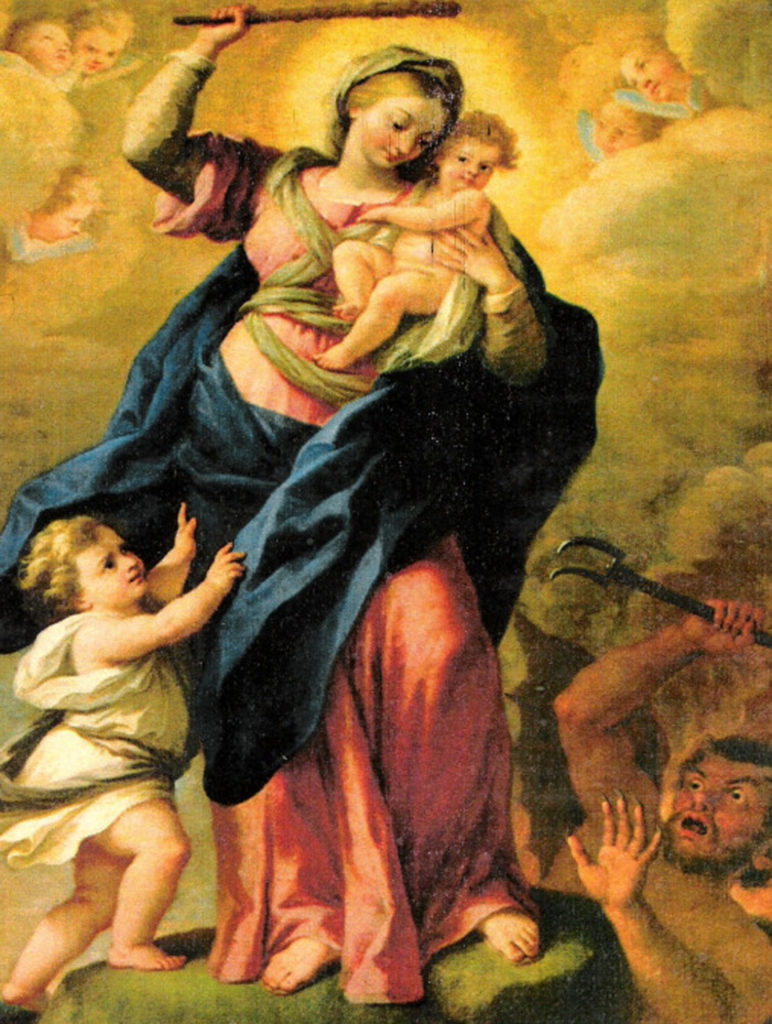
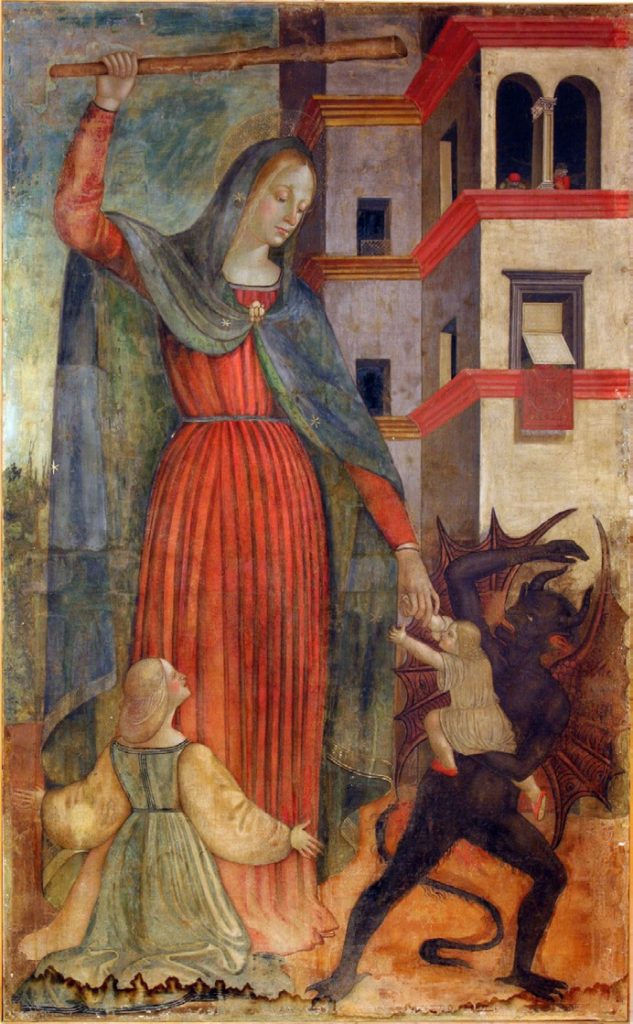
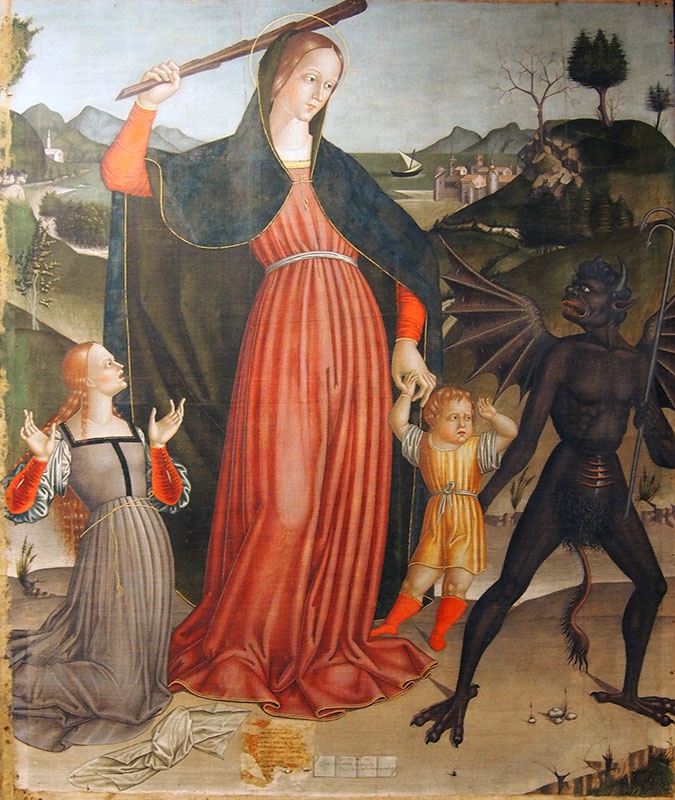
Our Lady of Succor, ladies and gents.

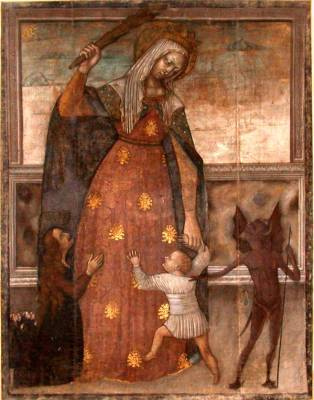
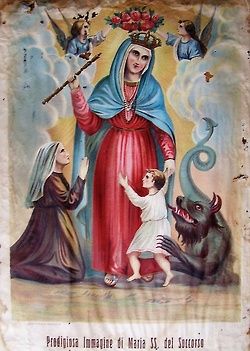

































Happy New Year to ya, Father! Besides September being a very Marian month with events like the birth of the Theotokos, it is also the start of the new liturgical year for us Byzantines (the liturgical year begins with Mary’s birth and ends with her dormition).
These images are beautiful. They are a good reminder to me when I forget that I am not fighting battles by myself, and reinforces the importance of praying the rosary daily. I happen to share a birthday with the Blesse Virgin. When I was a youngster, it was a back-to-school birthday. Now it’s very much a Marian birthday.
Thank you for the links to the Our Lady of Sorrows Project. This material supplements the novena material I have quite nicely.
One of Mary’s Greek titles is “Hypermachos Strategos” – the defending general.
[Excellent.]
Okay, actually “hypermachos” means “combatant for [our side]”, although that can be interpreted as defensive. The prologue to the Akathist hymn addresses Mary as “hypermachou strategou.” That part of the hymn is often associated with August 7, the day that Constantinople was miraculously saved from an Avar siege, which was attributed to Mary’s intercession.
In all the images, but one, there is a lady in the lower left beseeching Our Lady. Is it the mother of the child? This is a good reminder to all of us who are parents, especially those of us with adult children, to always place the care of their souls in Our Lady’s hands. Our Dearest Lady of Succor, pray for our children!
A very Marian September to Fr. Z and all.
Interesting, suburbanbanshee.
And in October we have Our Lady of the Rosary and Lepanto.
Pearl,
I’ve always wondered about the female figure on the left side. It is the child’s mother.
In the story, it seems that a child was being a real pest (and we all know how that goes). Maybe Mama was watching Magnumus della PI, and he was asking the usual questions: “Who is that? Why is he doing that? Who is she? Now what are they doing? That is so icky… can I have ice cream? There’s still ice cream in the freezer…”
Mama, knowing that her fantasy hour is ruined, yells, “oh, may the devil take you, you pest!”
The Devil (on cue) appears and starts to drag off her ‘pest’. She repents, and Our Lady appears, sagaciously wielding a weapon. The Mother of All Mothers not only beats the Devil into submission, but then, still holding the rescued child, walks over and stands on top of the Evil One.
I just learned that there is a procession held for her every year in Boston in August. Maybe next year they can hold it again.
“I also like to reflect on Mary in her “warrior mother” guise…”
Reminds me of an unusual Russian icon of Our Lady in which She is clothed in military attire.
Version #1: http://pravicon.com/images/icons/2/2748.jpg
Version #2: http://pravicon.com/images/icons/2/2750.jpg
[OORAH!]
Devotion to the Madonna del Soccorso, also known as the Madonna della Mazza (club) began in Sciacca, Sicily with the miraculous healing of an Augustinian. Other miracles followed, including the apparition of Our Blessed Mother holding a club to save a child from the devil. The Augustinians spread devotion to the Madonna del Soccorso to the regions of Italy. You can read more about the history here: https://web.archive.org/web/20080606102655/http://www.fishermansfeast.com/who_is_the_madonna_del_soccorso.htm
More info can be found on this Wikipedia page in Italian: https://it.wikipedia.org/wiki/Beata_Vergine_Maria_del_Soccorso
Okay, I looked up some stuff. “Hypermachos” was a title like “the king’s champion,” and was given to victorious generals who had successfully defended the kingdom in an outstanding way. But really, it’s an adjective turned into a noun.
The title “hypermachos” also appears in the Septuagint, as when Nicanor in 2 Mac. 8:36 says that the Jews had God fighting for them as their champion, and in Wis. 16:17, when the text notes that the cosmos acts as a champion or defender for the righteous. The military saint St. Demetrius is also described as a “hypermachos.” It’s a deep word.
The opening words of the Old Church Slavonic prologue to the Akathist hymn are “Vzbrannei voevode pobeditelnaia”, which is what’s written on the bottom of one of those Russian icons linked above.
Our Blessed Mother’s face in every painting above – there’s no anger, there’s no look of disgust, there’s no emotion, just a look of quiet confidence and control. Beautiful.
On my playlist for this month will be Palestrina’s setting of the sequence for the feast of Our Lady of Sorrows, the “Stabat Mater”. The best recording I’ve heard is on the Naxos label: https://www.naxos.com/catalogue/item.asp?item_code=8.553238
If you want a taste without buying, check out this youtube video that sets music to the score with english subtitles:
https://www.youtube.com/watch?v=6EWvz3ivfiI
It’s 20 stanzas long, at the 4:53 point it moves into the second 10 stanzas with so much emotion. “Holy Mother, do the following: Fix the wounds of the Crucified One firmly in my heart”
During September we traditionally reflect on Mary, especially in her role as Sorrowful Mother.
Do we? Interesting. I thought we reflect on the Angels.
In any case, we do reflect about the Blessed Virgin right now because it’s “Thirty Days of Our Lady” (Assumption through Feast of her Sorrows).
She walks softly but carries a big stick.
Yesterday I read the article, “Virgin Mary Statue Beheaded at Maronite Church in Toronto” and I was so infuriated. Then I looked down at Our Lady’s feet and she was still crushing the devil’s head. That made me smile.
I presumed the beseeching mother in the lower left corner was Holy Mother Church, the child being all of the children of the Bride of Christ. (Granted if there’s an authoritative reading of the image, I’m not aware of it.)
Here is an interesting illustrated miniature of the Madonna della Mazza found in a 14th century manuscript of Gautier de Coincy’s Les Miracles de Nostre-Dame: https://www.tygodnikpowszechny.pl/files/4_5.jpg
More info regarding this image can be found here: http://en.posztukiwania.pl/2016/09/27/our-lady-of-the-baton/
I know a priest who is involved in the healing and deliverance ministry of his diocese. He printed out a copy of the image of the Madonna del Soccorso and had it present during his sessions. He would invoke Our Lady to come with Her club. Needless to say, it turned out to be effective.
Another version of Stabat Mater (sung by JERYCHO, traditional Polish melody). Had this on the loop this past Lent.
https://youtu.be/T4ZySPfYdFw